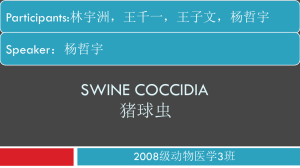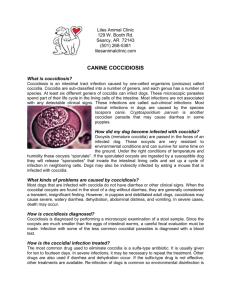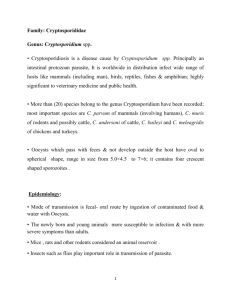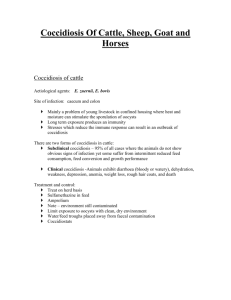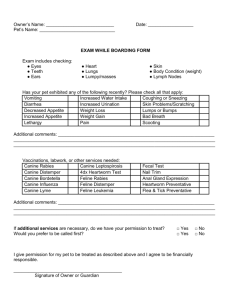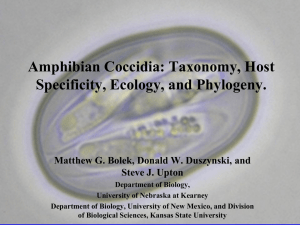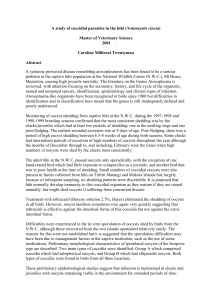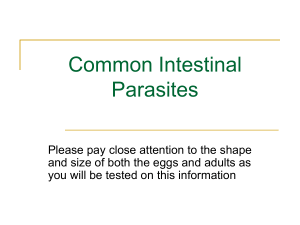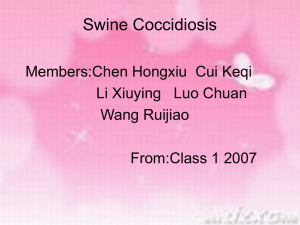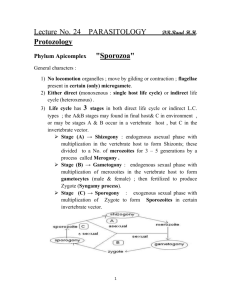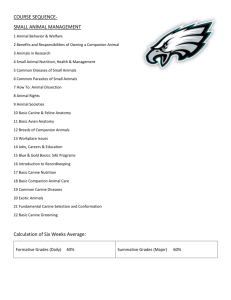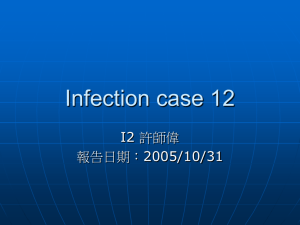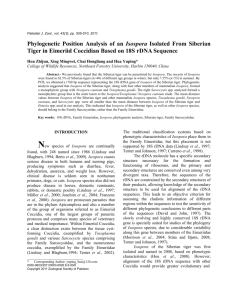Coccidia
advertisement
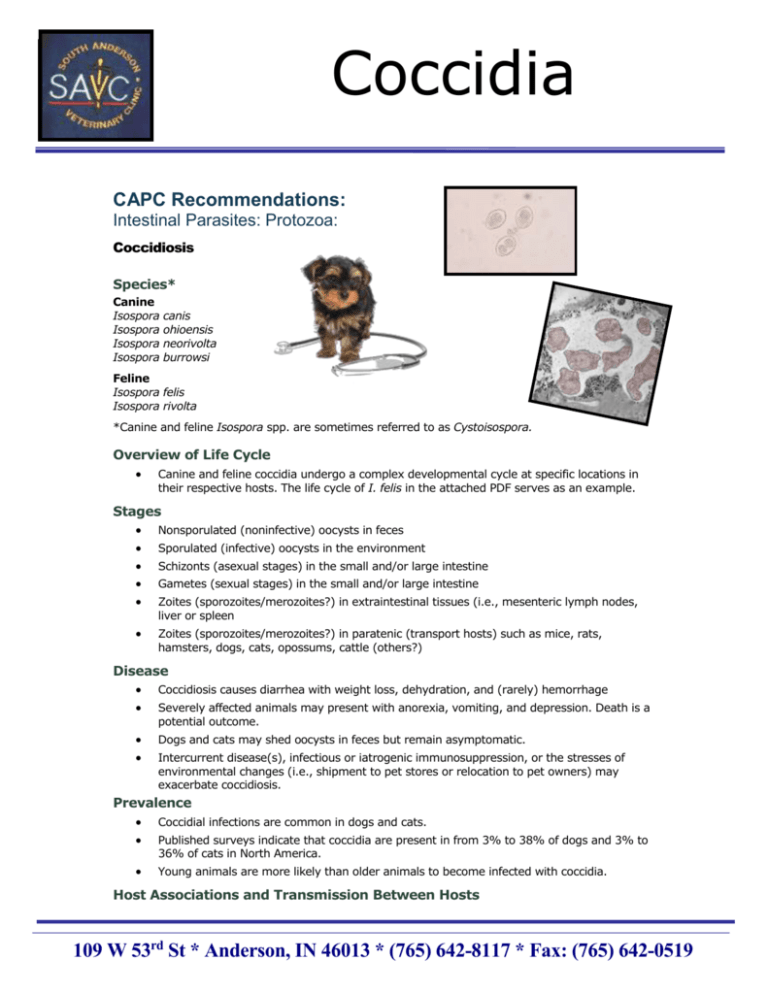
Coccidia Insert Logo CAPC Recommendations: Intestinal Parasites: Protozoa: Coccidiosis Species* Canine Isospora canis Isospora ohioensis Isospora neorivolta Isospora burrowsi Feline Isospora felis Isospora rivolta *Canine and feline Isospora spp. are sometimes referred to as Cystoisospora. Overview of Life Cycle Canine and feline coccidia undergo a complex developmental cycle at specific locations in their respective hosts. The life cycle of I. felis in the attached PDF serves as an example. Stages Nonsporulated (noninfective) oocysts in feces Zoites (sporozoites/merozoites?) in paratenic (transport hosts) such as mice, rats, hamsters, dogs, cats, opossums, cattle (others?) Sporulated (infective) oocysts in the environment Schizonts (asexual stages) in the small and/or large intestine Gametes (sexual stages) in the small and/or large intestine Zoites (sporozoites/merozoites?) in extraintestinal tissues (i.e., mesenteric lymph nodes, liver or spleen Disease Coccidiosis causes diarrhea with weight loss, dehydration, and (rarely) hemorrhage Dogs and cats may shed oocysts in feces but remain asymptomatic. Severely affected animals may present with anorexia, vomiting, and depression. Death is a potential outcome. Intercurrent disease(s), infectious or iatrogenic immunosuppression, or the stresses of environmental changes (i.e., shipment to pet stores or relocation to pet owners) may exacerbate coccidiosis. Prevalence Coccidial infections are common in dogs and cats. Young animals are more likely than older animals to become infected with coccidia. Published surveys indicate that coccidia are present in from 3% to 38% of dogs and 3% to 36% of cats in North America. Host Associations and Transmission Between Hosts 1234 PUPPYrd SUITE 100 • PETTOWN, COLORADO 89102 • 555-123-4567 • FAX 555-1231234 109 W 53 DRIVE St * •Anderson, IN 46013 * (765) 642-8117 * Fax: (765) 642-0519 Canine and feline coccidia are acquired by ingestion of sporulated oocysts from contaminated environments. Coccidiosis is also transmitted to dogs and cats by ingestion of transport hosts (predation) containing extraintestinal stages. Isospora spp. are rigidly host-specific. Canine coccidia will not infect felines leading to passage of oocysts in feces. The same is true for feline coccidia. Canine and feline Isospora spp. are not known to be of zoonotic significance. Prepatent Period and Environmental Factors Development of oocysts to infective sporulated oocysts (sporulation) does not occur above 40° C or below 20° C. Sporulation occurs rapidly (<16 hours) at temperatures between 30° C and 37° C. Sporulated oocysts are resistant to adverse environmental conditions and can survive as long as one year in moist, protected environments if they are not exposed to freezing or extremely high temperatures. Site of Infection and Pathogenesis Developmental stages reside in either cells lining the intestinal villus (enterocytes) or cells within the lamina propria of the villus. Maturation and emergence of asexual and sexual stages from infected cells causes cell lysis. This damage can be especially severe when caused by species that develop within cells in the lamina propria. Zoites (sporozoites/merozoites?) also are found in extraintestinal tissues (i.e., mesenteric lymph nodes, liver, or spleen) of definitive or paratenic hosts. These resting or latent stages are not thought to cause clinical disease. Treatment Sulfadimethoxine is the only drug that is label approved for treatment of enteritis associated with coccidiosis. Numerous additional drugs and drug combinations have been used with some success. Among the newer drugs, ponazuril appears to be effective, according to published research and use testimonials. Control and Prevention In addition to treatment, appropriate sanitation in addition to treatment is helpful in the prevention of spread of coccidiosis in kennels and catteries. Oocysts sporulate quickly once in the environment; therefore daily removal of feces can aid in the prevention of coccidiosis. After they are infective, oocysts are resistant to most commonly used disinfectants. Infective oocysts can survive for many months in the environment. Disinfectants containing high concentrations of ammonia can destroy oocysts, but their harmful odors and the necessity of removing animals from runs or cages during treatment limit their use. Public Health Considerations Because humans are not susceptible to Isospora infections in dogs and cats, canine or feline coccidia are not considered zoonotic agents. It should be kept in mind that Toxoplasma gondii is a zoonotic agent. Oocysts are passaged in feline feces, but are much smaller than those of Isospora spp For More information: http://www.capcvet.org/recommendations/Coccidia.html www.SouthAndersonVet.com 109 W 53rd St * Anderson, IN 46013 * (765) 642-8117 * Fax: (765) 642-0519
